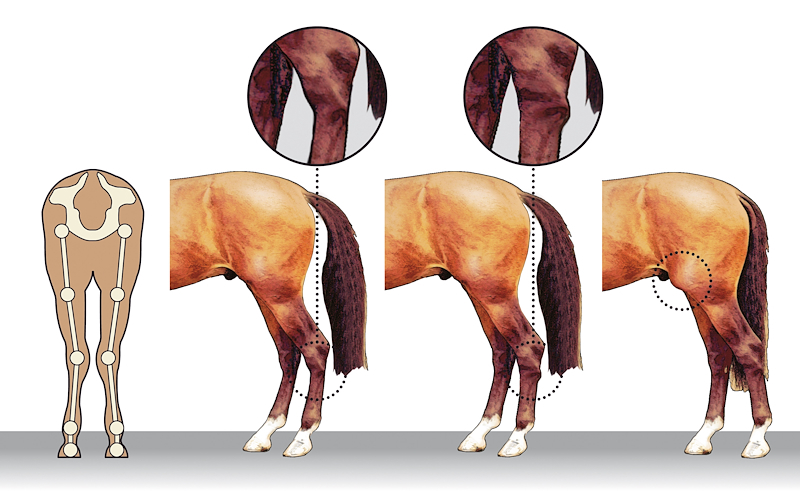Correct conformation: Both front and behind
The KWPN pays close attention to correct conformation, which allows the horse to perform its work easily and, as a result, enjoy a long sport career. Correct leg conformation is an important part of this concept. Together with Dr. Harold Brommer of the University Clinic for Horses in Utrecht and inspectors Floor Dröge and Henk Dirksen, we once again shine a light on this subject.
Several abnormalities may be found on both the front- and hind legs. When juding the leg conformation, the jury first looks for a constricted or tied-in cannon bone. When this abnormality is present, which can be seen from the side, the circumference of the cannon bone just below the knee or hock is smaller than the circumference of the cannon bone farther down towards the fetlock. “This actually has no clinical significance: it’s more of a cosmetic blemish. But the power can’t be transmitted as well, and it’s therefore not ideal”, say all parties.
Pastern angle is also important in both the front- and hind leg. If it is very sloped or ‘weak’, the pastern drops too far due to hyper-extension of the surrounding structures; or if it is straight, the pastern and pastern joint have little mobility. Both inspectors point to the danger of a weak pastern stance: “We see increasingly more horses with a weaker pastern. This often gives more elasticity in motion, but watch out, because it shouldn’t be too weak. It’s for a good reason that several years ago we also started scoring the hind leg pastern angle. We really have to watch that this stays strong enough.” Brommer: “From a veterinary perspective, a slightly straighter pastern stance is more favourable than a slightly weaker one. A weak pastern stance puts more stress on the suspensory ligament with possible injuries as a result. This often creates problems, certainly with a straight hock. If you more or less have a normal foot shape with a weak pastern position, it may still be all right; but if you also have a horse with little heel, then there’s really an increased risk of injuries. It seems that we’re seeing more soft tissue problems in the lower leg these days, but I think this has to do with years of selection for bone defects, such as poor-quality sesamoid bones and navicular; the soft tissue problems are now more often the cause of lameness. Let me finish by saying that I always prefer to see a correct horse over a horse with stance abnormalities. It contributes to the proper functioning and quality of a horse’s movement. Breeding should therefore always strive for correctness. But by no means do all stance abnormalities have a clinical significance, and especially horses with minor abnormalities can often function very well.” Dröge: “At the inspections, we look at horses from a breeding perspective. We want to breed as correct and healthy as possible. For an individual sport horse, a less ideal leg stance isn’t such a big issue; but it shouldn’t be a problem on the population level.” And Dirksen concludes: “Our predecessors have always selected for correctness. I think that’s the power of the KWPN. And look closely: the higher you go in the sport, the greater the percentage of correct horses. That says it all.”
The KWPN pays close attention to correct conformation, which allows the horse to perform its work easily and, as a result, enjoy a long sport career. Correct leg conformation is an important part of this concept. Do you want to know more about a correct conformation? Then order the book 'the KWPN Horse; selection for performance' here. KWPN members order the book for € 19.95 and non-members for € 24.50.























 KWPN Database
KWPN Database KWPN.tv
KWPN.tv KWPN Horses for Sale
KWPN Horses for Sale